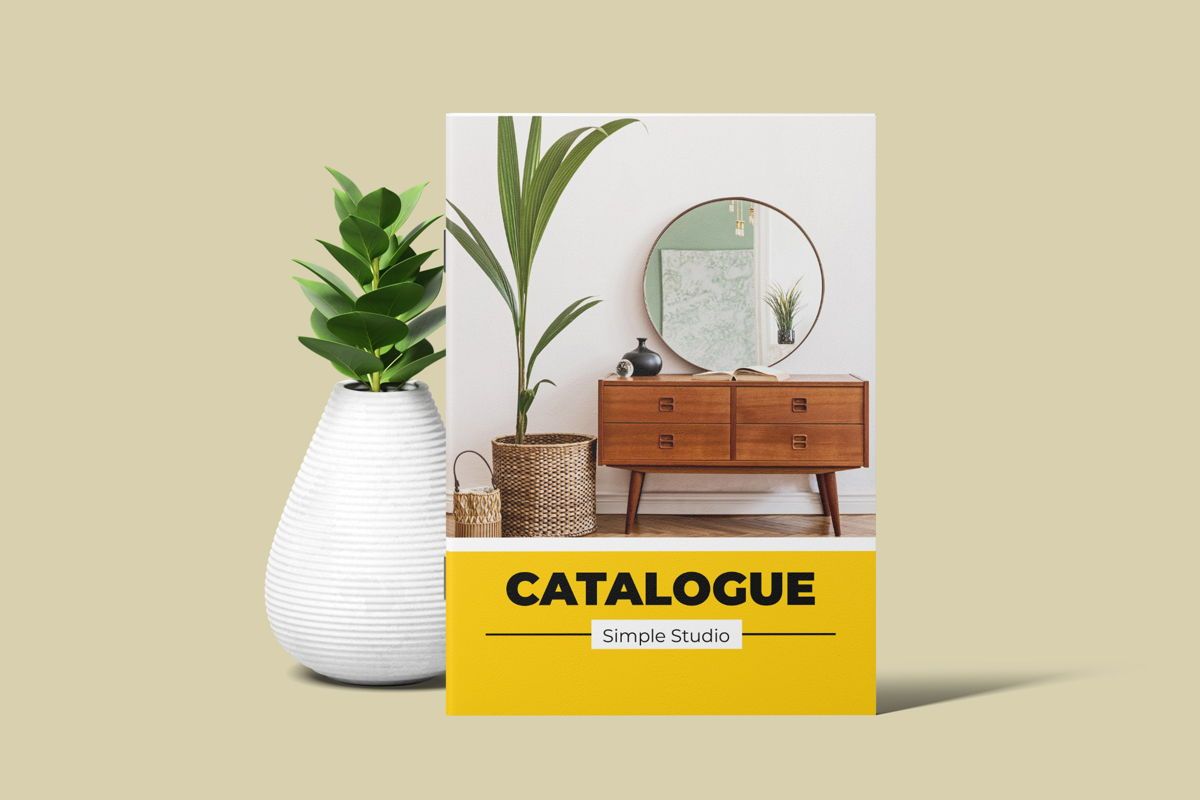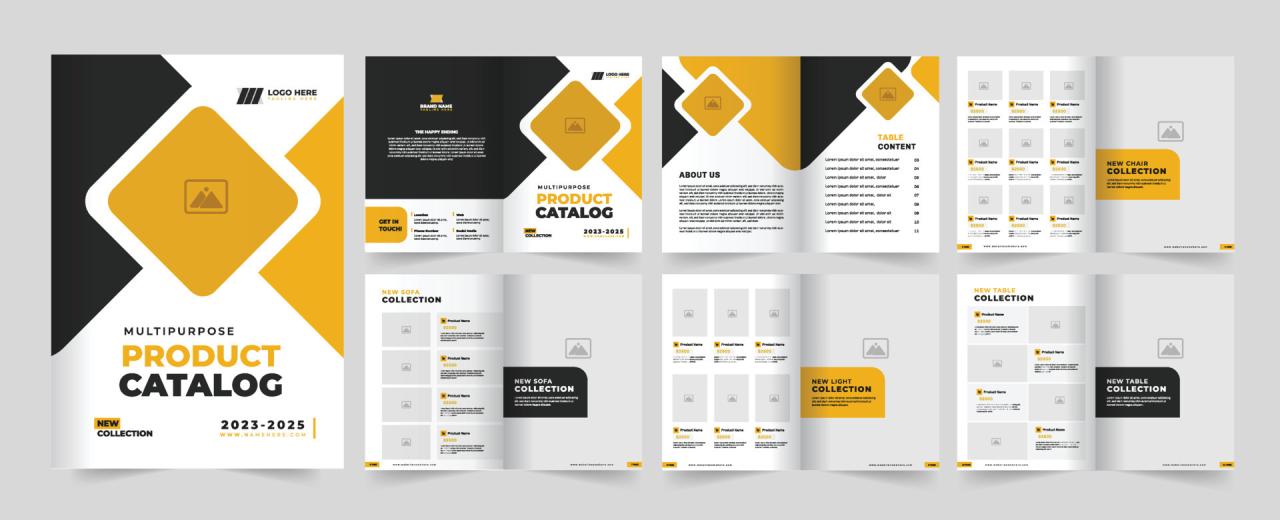
Best Product Catalog Template Your Guide
Best product catalog template selection is crucial for showcasing your products effectively. Creating a compelling catalog isn’t just about pretty pictures; it’s about strategically presenting your offerings to convert browsers into buyers. This guide dives into the key elements of designing, creating, and distributing a high-impact product catalog, whether you’re aiming for print, digital, or both.
We’ll cover everything from choosing the right template based on your target audience and industry to optimizing your catalog for various devices and ensuring accessibility for all users. Get ready to transform your product presentation and boost your sales!
Defining “Best” Product Catalog Templates

Source: poweredtemplates.com
Choosing the right product catalog template can significantly impact your sales and brand image. A well-designed catalog not only showcases your products effectively but also enhances the overall customer experience. This means defining “best” goes beyond simple aesthetics; it requires a holistic evaluation of several key factors.
The ideal product catalog template is more than just visually appealing; it needs to be functional, user-friendly, and perfectly aligned with your brand and target audience. This requires careful consideration of several critical elements, extending beyond superficial design choices.
Criteria for Evaluating Product Catalog Templates
Several key criteria determine the quality of a product catalog template. These criteria can be grouped into usability, aesthetics, and functionality, allowing for a comprehensive evaluation.
To effectively assess a template, a rubric is essential. This rubric should assign weighted scores to different aspects, ensuring a balanced evaluation.
| Criteria | Excellent (3 points) | Good (2 points) | Fair (1 point) | Poor (0 points) |
|---|---|---|---|---|
| Usability (Navigation, Search, Responsiveness) | Intuitive navigation, robust search functionality, seamless responsiveness across devices. | Mostly intuitive navigation, functional search, generally responsive. | Navigation issues, limited search, responsiveness problems on some devices. | Difficult navigation, broken search, poor responsiveness. |
| Aesthetics (Visual Appeal, Branding Consistency) | Visually stunning, consistent with brand guidelines, high-quality imagery. | Visually appealing, mostly consistent with branding, good-quality imagery. | Visually adequate, some branding inconsistencies, mixed image quality. | Visually unappealing, significant branding inconsistencies, poor image quality. |
| Functionality (Product Display, Customization Options, Integration) | Clear product displays, extensive customization options, seamless integration with e-commerce platforms. | Good product displays, sufficient customization, generally good integration. | Some product display issues, limited customization, integration challenges. | Poor product displays, minimal customization, poor or no integration. |
Target Audience Consideration, Best product catalog template
The success of any product catalog hinges on its ability to resonate with the target audience. A template designed for a luxury brand will differ significantly from one intended for a budget-conscious consumer base. Consider factors like age, demographics, and purchasing habits when selecting a template.
For example, a younger demographic might respond better to a modern, minimalist design with bold colors and interactive elements, while an older demographic might prefer a more classic, clean design with clear typography and high-quality product photography. Ignoring your target audience can lead to a catalog that fails to connect with potential customers.
Design Style Comparisons
Different design styles cater to various brand identities and target audiences. Understanding these styles is crucial for selecting the most effective template.
A minimalist design prioritizes simplicity and clean lines, often featuring a limited color palette and ample white space. This style is ideal for showcasing high-quality products and conveying a sense of sophistication. Imagine a catalog for a high-end furniture brand, using predominantly white space, high-resolution images, and minimal text. The focus is entirely on the product itself.
A modern design incorporates contemporary trends, often featuring bold typography, vibrant colors, and dynamic layouts. This style is perfect for brands that want to project a sense of innovation and energy. A tech gadget catalog might use a modern design with sleek gradients, geometric shapes, and a focus on visual impact.
A classic design emphasizes timeless elegance and sophistication, usually featuring a more traditional layout with a refined color palette and elegant typography. This style is well-suited for brands that want to project a sense of heritage and trustworthiness. Think of a catalog for a long-established jewelry company; it might utilize a classic design with muted tones, elegant fonts, and a focus on detailed product descriptions.
Types of Product Catalog Templates

Source: vecteezy.com
Choosing the right product catalog template is crucial for effectively showcasing your products and driving sales. The format you select will significantly impact how your customers experience your offerings, influencing their perception of your brand and ultimately, their purchasing decisions. Different formats cater to various needs and target audiences, making careful consideration essential.
Product catalogs come in a variety of formats, each with its own strengths and weaknesses. Understanding these differences is key to creating a catalog that resonates with your customers and achieves your business goals. Let’s explore the main types available.
Print Catalogs
Print catalogs offer a tangible, tactile experience that many consumers still appreciate. The high-quality visuals and physical feel can create a sense of luxury and prestige, particularly effective for high-end products. A well-designed print catalog can act as a lasting marketing tool, potentially being kept and referred to over time. However, print catalogs are expensive to produce and distribute, and updating them requires a complete reprint, making them less flexible than digital alternatives.
Successful examples include high-end fashion brands like Burberry or luxury home goods catalogs. Imagine a thick, glossy catalog featuring stunning photography of exquisitely crafted furniture, each piece detailed with precise descriptions and pricing.
Digital Catalogs
Digital catalogs, often in PDF format, are cost-effective and easily distributed via email or website. They offer flexibility with easy updates and revisions, and can incorporate interactive elements like clickable links and embedded videos. However, the digital format can lack the tactile appeal of a print catalog, and may not be as memorable for some consumers. Many technology companies, such as Apple, utilize sleek digital catalogs showcasing their latest products with high-resolution images and detailed specifications.
Think of a clean, minimalist PDF featuring crisp product shots and detailed technical specifications, easily downloaded and shared.
Finding the best product catalog template can be a game-changer for your business, especially when you’re trying to boost sales. To really make an impact, though, you need to get your products in front of the right audience, which is why I highly recommend checking out this awesome guide on getting it on with youtube – seriously, it’s a fantastic resource for marketing your catalog effectively.
Once you’ve mastered the video side of things, you’ll see how a great catalog template truly shines.
Interactive Catalogs
Interactive catalogs, often web-based or app-based, offer the most engaging experience. They can incorporate features such as 360° product views, zoom capabilities, videos, and customer reviews. This immersive experience significantly enhances customer engagement and provides a more comprehensive understanding of the products. However, they require more technical expertise to create and maintain, and may not be accessible to all customers due to technological limitations.
Companies selling complex products, such as automobiles or medical equipment, often benefit from interactive catalogs that allow customers to explore features in detail. Visualize a car catalog where you can virtually “walk around” a vehicle, explore the interior, and view different color options.
Comparison of Catalog Formats
| Format | Pros | Cons | Suitable Industries |
|---|---|---|---|
| Tangible, high-quality visuals, lasting impact | Expensive, inflexible, difficult to update | Luxury goods, high-end fashion, home decor | |
| Digital (PDF) | Cost-effective, easy distribution, easily updated | Lacks tactile appeal, less memorable | Technology, electronics, software |
| Interactive | Engaging, immersive experience, detailed product information | Requires technical expertise, may not be accessible to all | Automotive, real estate, complex products |
Pre-designed vs. Custom-designed Templates
Pre-designed templates offer a cost-effective and time-saving solution, providing a ready-made framework that can be quickly customized with your brand’s content and imagery. However, they may lack the unique design elements necessary to truly differentiate your brand. Custom-designed catalogs offer complete creative control, ensuring a unique and impactful presentation tailored specifically to your brand identity and product range.
However, they are significantly more expensive and time-consuming to develop. The choice depends on your budget, timeline, and the level of brand differentiation you require. A small business with limited resources might opt for a pre-designed template, while a large corporation launching a new product line might invest in a custom design.
Key Features of Effective Product Catalog Templates

Source: behance.net
Creating a truly effective product catalog isn’t just about slapping together some images and descriptions. It’s about crafting a compelling visual and informational experience that drives sales. A well-designed catalog acts as a silent salesperson, showcasing your products in the best possible light and guiding customers towards a purchase. This requires careful consideration of several key features.
High-converting product catalogs leverage a combination of professional design, clear communication, and strategic placement of elements to encourage engagement and conversions. Let’s delve into the specifics.
High-Quality Images and Clear Product Descriptions
High-resolution images are paramount. Think professional photography, ideally showcasing the product from multiple angles, highlighting key features, and demonstrating its use in context. Imagine a catalog featuring a new line of hiking boots. Instead of a single, poorly lit studio shot, you’d see images of the boots in action on a trail, showcasing their durability and comfort. Accompanying these visuals should be clear, concise, and benefit-driven product descriptions.
Instead of simply stating “durable hiking boots,” describe them as “lightweight, waterproof hiking boots designed for all-day comfort on challenging terrains, featuring reinforced stitching and a Vibram sole for superior grip.” This provides valuable information while emphasizing the advantages for the customer.
Best Practices for Showcasing Products Effectively
Effective product presentation is crucial. Consider these best practices:
A well-organized layout is essential for easy navigation. Group similar products together, use clear headings and subheadings, and ensure consistent formatting throughout the catalog. Think of it like a well-organized store; customers should easily find what they’re looking for. Furthermore, incorporating white space prevents the catalog from feeling cluttered and overwhelming. White space allows the eye to rest and focus on individual products.
Finally, using a consistent grid system ensures visual harmony and a professional appearance.
Incorporating Customer Reviews and Testimonials
Social proof is a powerful tool. Including positive customer reviews and testimonials adds credibility and builds trust. For example, you might feature a quote like: ” These boots are amazing! I’ve hiked hundreds of miles in them, and they’ve held up perfectly. Highly recommend!” – John D., Verified Buyer. This adds authenticity and reassures potential customers about the quality and performance of your products. Strategically placing these testimonials throughout the catalog, especially near the products they refer to, can significantly impact purchasing decisions.
Consistent Branding and Visual Identity
Maintaining a consistent brand identity is crucial for creating a cohesive and professional image. This includes using your brand’s logo, color palette, and typography consistently throughout the catalog. Imagine a catalog with a vibrant, modern logo, but then using a dull, outdated font for the product descriptions. The inconsistency would undermine the overall brand image. Consistent branding reinforces recognition and strengthens your brand’s message, ensuring a unified and professional impression on potential customers.
Creating a Compelling Product Catalog
Crafting a truly effective product catalog goes beyond simply listing your products; it’s about creating a visually appealing and informative experience that drives sales. A well-designed catalog acts as a powerful sales tool, showcasing your brand and persuading customers to purchase. Consider it a mini-magazine dedicated to your products.
Sample Product Catalog Layout
A strong layout guides the reader’s eye and facilitates easy navigation. The following Artikels a sample structure, emphasizing clear organization and visual hierarchy.
- Cover Page: Brand logo, tagline, and a captivating hero image showcasing a flagship product or a lifestyle associated with your brand. Consider a clear and concise title, such as “Spring Collection 2024” or “The Ultimate Guide to [Product Category]”.
- Table of Contents: A quick reference guide for easy navigation, especially for larger catalogs.
- Product Sections: Organize products into logical categories (e.g., by type, feature, or price range). Each section should have a clear heading and potentially a brief introductory paragraph highlighting the key benefits of that product category.
- Individual Product Pages: Each product should have its own dedicated spread (or at least a generous amount of space) featuring high-quality images, concise yet descriptive text, and clear pricing information.
- Company Information/Contact Details: Include your company logo, website, contact information, and social media links in a clearly visible location.
- Back Cover: A call to action (e.g., a special offer, website address, or contact information), potentially a striking image, and your company logo.
Selecting Appropriate Imagery
High-quality images are paramount. Poor-quality images detract from the professionalism of your catalog and can negatively impact sales.The resolution should be at least 300 DPI (dots per inch) for print and a minimum of 72 DPI for digital versions. However, higher resolutions are always preferred. Images should be well-lit, sharp, and accurately represent the product’s color and texture.
Consider using a consistent style across all images – lifestyle shots that show the product in use often work better than sterile product-only shots. For example, instead of a plain image of a coffee mug, show someone enjoying a cup of coffee in a cozy setting with the mug prominently featured.
Compelling Product Descriptions
Product descriptions should be concise, informative, and persuasive. Focus on the benefits, not just the features. Instead of saying “This mug is made of ceramic,” say “Enjoy your morning coffee in this elegant, durable ceramic mug, keeping your drink warm for longer.” Use strong action verbs and evocative language to create a sense of desire.Here are some examples:* Weak: “This is a blue shirt.”
Strong
“This vibrant blue shirt is made from breathable cotton, perfect for a summer day. Its classic cut ensures a comfortable and stylish fit.”* Weak: “This laptop has a fast processor.”
Strong
“Experience lightning-fast performance with this laptop’s cutting-edge processor. Seamless multitasking and rapid boot times will transform your workflow.”
Whitespace and Typography
Effective use of whitespace (empty space) creates a clean, uncluttered look, improving readability and visual appeal. Avoid cramming too much information onto a single page. Use generous margins and spacing between elements.Typography plays a crucial role in readability and brand identity. Choose fonts that are easy to read, both in print and online. Use a clear hierarchy of headings, subheadings, and body text to guide the reader’s eye.
Consider using a sans-serif font for body text and a serif font for headings to create visual contrast and enhance readability. Ensure sufficient contrast between text and background colors for optimal readability.
Distribution and Accessibility of Product Catalogs
Getting your product catalog into the hands (or onto the screens) of your potential customers is crucial for success. Choosing the right distribution method and ensuring accessibility for everyone are key elements in maximizing your catalog’s impact and reach. This involves considering both traditional and digital approaches, as well as the needs of users with diverse abilities.
Methods for Distributing Product Catalogs
Effective distribution depends on your target audience and brand strategy. A multi-channel approach often yields the best results. For example, a luxury goods company might prioritize a high-quality print catalog mailed to select customers, while a tech startup might focus on a dynamic online catalog and targeted email campaigns.
- Online Catalogs: Website integration is essential. A well-designed online catalog offers easy navigation, search functionality, zoom capabilities for detailed product views, and seamless integration with e-commerce platforms for direct purchasing. Think of how easily you can browse Amazon’s catalog and add items to your cart.
- Print Catalogs: While declining in popularity, print catalogs still hold value for certain businesses. They offer a tangible experience, particularly appealing for high-end products or businesses targeting older demographics. Consider the tactile quality of a well-designed, high-quality paper catalog from a brand like Pottery Barn.
- Email Marketing: Email is a powerful tool for distributing catalog snippets or directing customers to your online catalog. Targeted email campaigns can be highly effective in reaching specific customer segments. Imagine receiving an email highlighting new seasonal items from your favorite clothing brand.
- Social Media: Platforms like Instagram and Pinterest can showcase product images and links to your online catalog, leveraging visual marketing to attract customers.
Optimizing Product Catalogs for Various Devices
Responsiveness is key. Your catalog should seamlessly adapt to different screen sizes and orientations. This ensures a consistent user experience across desktops, tablets, and smartphones. Failure to optimize for mobile devices will likely result in a poor user experience and lost sales.
- Responsive Design: Utilize responsive design principles to ensure your catalog automatically adjusts its layout to fit the device’s screen size. This avoids the need for separate versions for each device.
- Image Optimization: Use appropriately sized images to avoid slow loading times, especially on mobile devices. Compressing images without sacrificing quality is crucial for a smooth browsing experience.
- Touchscreen Optimization: Ensure buttons and interactive elements are large enough for easy tapping on touchscreens.
Accessibility Features for Users with Disabilities
Inclusivity is paramount. Designing an accessible catalog ensures everyone can access and enjoy your products. This is not only ethically responsible but also expands your potential customer base.
- Alt Text for Images: Provide descriptive alt text for all images so screen readers can convey the image content to visually impaired users. For example, instead of “image1.jpg,” use “A stylish red handbag with a gold clasp.”
- Keyboard Navigation: Ensure users can navigate the catalog entirely using their keyboard, without relying on a mouse. This is essential for users with motor impairments.
- Color Contrast: Maintain sufficient color contrast between text and background to improve readability for users with visual impairments.
- Structured HTML: Using semantic HTML helps screen readers understand the content structure and order, making navigation easier for users with disabilities.
Best Practices for Managing and Updating a Digital Product Catalog
Regular updates are crucial for keeping your catalog current and relevant. This involves efficient content management and a streamlined update process.
- Content Management System (CMS): Using a CMS simplifies the process of adding, editing, and deleting products. Popular options include WordPress, Shopify, and Wix.
- Version Control: Maintain version history to easily revert to previous versions if needed.
- Automated Updates: Where possible, automate updates to reduce manual effort and ensure consistency.
- Regular Audits: Periodically review your catalog for broken links, outdated information, and accessibility issues.
Final Wrap-Up: Best Product Catalog Template
Designing the perfect product catalog is a journey, not a destination. By carefully considering your target audience, choosing the right template and format, and paying close attention to design elements like imagery, descriptions, and layout, you can create a compelling tool that drives sales. Remember, a well-designed catalog is an investment in your brand and a powerful way to connect with your customers.
So, get started, and watch your sales soar!
FAQ Corner
What file formats are best for online product catalogs?
PDFs are popular for their consistent appearance across devices, but interactive catalogs using HTML5 can offer richer experiences.
How can I ensure my catalog is mobile-friendly?
Use a responsive design template that adapts to different screen sizes. Test your catalog on various devices to ensure optimal viewing.
Where can I find high-quality product images?
Stock photo sites offer a vast selection, but professional photography is best for a premium look. Ensure images are high-resolution.
What are some effective call-to-actions for a product catalog?
Clear, concise calls to action like “Shop Now,” “Learn More,” or “View Details” with prominent placement drive conversions.
